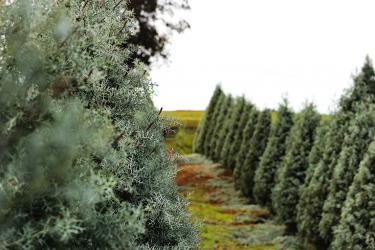It’s hard to beat the excitement of finding the perfect real Christmas tree for your home. The smell of fresh pine, finding the best spot in your home and breaking out your favorite ornaments is a feeling that can’t be beat. To help you harness this Christmas magic, here is some can’t miss info on the season’s most popular pine tree.
Checking for Freshness
One of the most important parts of getting a real tree is making sure it’s fresh. One of the easiest ways to do this is to pull one of the branches. If a few needles come off once it’s pulled, the tree is fresh!
Decking the Halls
When cared for properly, most Christmas trees will last between 4 to 6 weeks. The most popular time to buy a tree is the weekend after Thanksgiving or the following week. This way, buyers can get the optimal amount of time out of their real tree. An important tip is to trim the trunk of your tree right before you put it into the tree stand. If you wait too long to put the tree into the stand with water, sap will form over the cut preventing water from entering the tree. Giving the trunk a fresh cut is a great way to prevent this from happening!
Reuse or Recycle
Once the holidays are over and your tree is turning brown or losing needles, it’s time to dispose of your real Christmas tree. A lot of communities offer Christmas tree pickup; check your county’s website for more information on home pick-ups. There’s also multiple drop-off locations around St. Louis. These lists are updated each year and can be found on St. Louis County’s website (www.stlouiscountymo.gov). Make sure to remove all ornaments and decorations from the tree before dropping them off!
If you want to utilize your tree after the holidays, there are multiple ways to preserve parts of your real tree! Using tree parts as habitats for wildlife - for example a pond habitat - is a popular option. You can also cut the trunk of the Christmas tree to make coasters or homemade decorations for next year, the possibilities are endless!
Types of Christmas Trees
Balsam fir
Best known for their scent, Balsam fir trees are recognized by the conical shape and dark, flat needle-like leaves. An easy way to distinguish between a fir and a spruce is to check the consistency of the needles—fir trees have soft needles that are easy to roll between your fingers.
Scotch pine
Due to their ability to not drop needles, these trees are great for homeowners who want a real tree with minimal mess. With dark green leaves and sturdy branches, these trees can hold some seriously heavy ornaments.
Fraser fir
A Fraser fir can be identified by its upturned branches and dark blue-green shade. The tree is very similar to a Balsam fir but is more compact due to the shape of its branches. The average lifespan of a Fraser fir once it’s cut is five weeks.
Norway spruce
Only being grown for Christmas trees more recently, the Norway spruce is a tree for homeowners who are dedicated to putting more effort into their tree’s upkeep. The tree itself is known for dropping needles and needing additional attention when it comes to watering, but its unique shape and branch size sets it apart from more traditional trees.
Additional tip: Make sure your tree stand always has water the first few days you have your tree. The tree will soak up a lot of water in the beginning!









